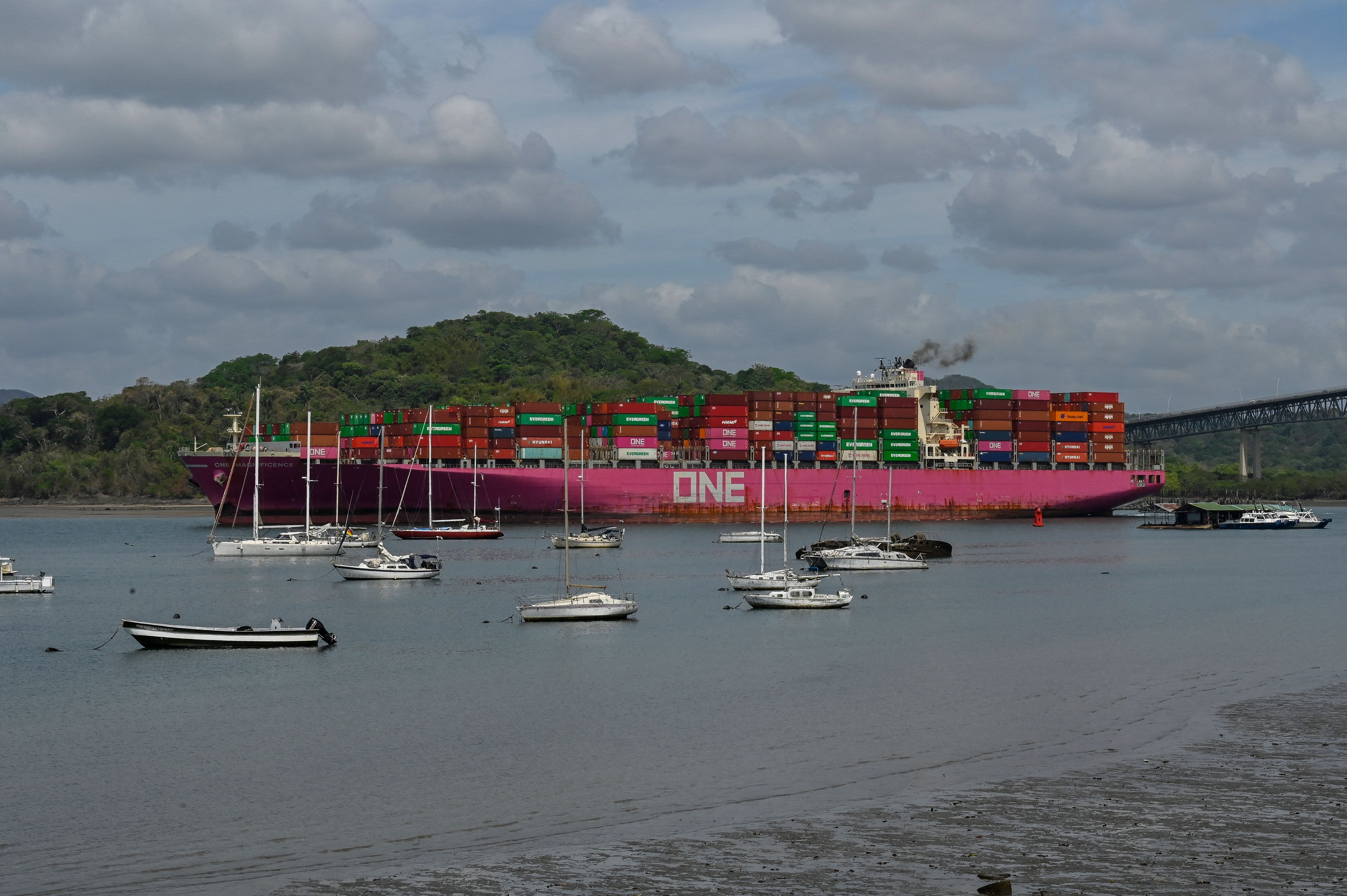
- There are 154 commercial vessels waiting to transit the Panama Canal with an average waiting time of 21 days.
- The Panama Canal Authority has reduced the number of ships allowed to pre-book through the Panamax locks, and restrictions due to ongoing dry conditions will remain in effect through August 21.
- 40% of container traffic in the United States passes through the Panama Canal each year.
- “This will get worse before it gets better,” said one shipping expert.
A ship sails through the Panama Canal in the area near the Bridge of the Americas in Panama City on April 24, 2023. A scarcity of rainfall due to the Panama Canal has forced to reduce the tow of ships passing through the waterway between the two oceans, in the midst of a water supply crisis that threatens the future of this sea route. .
Luis Acosta | Afp | Getty Images
The number of ships waiting to transit the Panama Canal has reached 154, and slots for carriers to book passage have been reduced in an effort to manage congestion caused by persistent dry conditions that have plagued the main shipping gateway since spring. The current waiting time to cross the channel is now about 21 days.
The Panama Canal is an important trade link for US shippers heading to Gulf and East Coast ports. The United States is the largest user of the Panama Canal, with total US goods exports and import containers accounting for about 73% of Panama Canal traffic. Forty percent of all container traffic in the United States travels through the canal each year, about $270 billion worth of cargo.
This massive backlog is the result of water conservation measures deployed by the Panama Canal Authority in late July due to drought. PCA has temporarily reduced the availability of booking slots from August 8 to August 21 for Panamax vessels, the largest vessels that can transit the canal. These ships could carry 4,500 twenty-foot equivalent units (TEUs). The number of pre-booking slots has been reduced from 23 to 14.
Satellite imagery from Planet Labs shows the crowding.
Ships waiting to cross the Panama Canal from the Pacific side. The red square indicates the Panama Canal
Planet Labs BBC
Additional low-water restrictions imposed by the CTC in July required ships to be 40% lighter, affecting ships in transit when the requirement was implemented. Ever Max was forced to unload 1,400 containers at Port Balboa in order to meet requirements and gain passage. The ship is currently docked in the port of Savannah.
“Those remaining containers will need another ship to complete the journey,” said Captain Adel Ashiq, president of Marine Traffic North America. “This will get worse before it gets better,” he said.
The canal lock loses 50 million gallons of water when a single vessel passes the canal. Water levels in Gatun Lake, which feeds the canal, have fallen to their lowest level in four years.
Given the changing conditions, the canal maintains an open line of communication to keep customers informed about the availability of a booking slot, said Ricaurte Vásquez Morales, director of the Panama Canal. “Through regular updates, transparent dialogue and close collaboration with shipping lines and stakeholders, we strive to manage expectations and provide real-time information that enables our customers to make informed decisions,” he said.
Ashiq explained that ships have to wait longer to cross the canal or the ocean to make a commercial decision to take alternative routes, which adds time and fuel costs to the journey. Shippers who use multiple vessels to move their shipments add to freight costs and longer lead times to secure bookings. Ultimately, he said, those costs may end up being passed on to businesses and consumers.
Recent data from supply chain intelligence firm Descartes shows that East Coast ports continue to be the preference for US shipping companies. The ports of the West Coast saw a 38.3% decrease in July trade, and the top ports of the East Coast and the Persian Gulf witnessed a decrease of 46.4%.
“Now is not the time to put more stress on supply chains that are still under constant logistical stress,” said Stephen Lamarr, president and CEO of the American Apparel and Footwear Association. He said the additional fees and restrictions on ships will likely mean higher prices for clothing and shoes for American consumers this holiday season.
This latest reduction in bookings came on the heels of the Partnership and Cooperation Agreement, which reduced the number of ships allowed to pass through the canal in a single day. As of July 30, 2023, the daily transportation capacity of the Panama Canal has been revised to an average of 32 vessels per day (10 vessels in the newer Neopanamax locks, which serve larger vessels, and 22 vessels in the older Panamax locks). Prior to water conservation measures, transit was 34 to 36 per day.
Alan Baer, CEO of logistics company OL USA, told CNBC that shippers may have to start looking for other ways.
“With access to the East Coast of the United States through the Panama Canal becoming increasingly difficult, importers may be looking for ships to pass through the Suez Canal,” Baer said. He added that this could be an effective solution for freight coming from the ASEAN region and some southern Chinese origins. However, for North China and North Asia, deviating by Suez can add seven to 14 days extra transit time.
Energy sector transformations are already happening
Transformations are already happening in the energy sector. According to S&P Global, mounting delays have clean tankers, transport refined petroleum products, avoid the canal, and shift their preference to booking routes to the Atlantic Basin. Data from the Commodities at Sea unit shows that for the June-July combined period, exports of clean petroleum products from the US Gulf Coast using the Canal and traveling to the West Coast of South America slowed by 82% year over year. In July, exports specifically fell by 12% year-on-year.
Cheniere Energy announced in July that it would bypass the Panama Canal for LNG shipments due to wait times. The canal is the fastest route to Asia for the LNG market. Coal traffic is also affected and adjustments are made. India is a large importer of US coal, and ships carrying the commodity also use the Panama Canal.

“Travel specialist. Typical social media scholar. Friend of animals everywhere. Freelance zombie ninja. Twitter buff.”




More Stories
Sadiq Khan re-elected Mayor of London in Labour’s latest victory
Sadiq Khan has won a third term as Mayor of London, capping off Labour’s strong performance in the English local elections
Israel informed the United States of a plan to evacuate Palestinian civilians ahead of the possible Rafah operation